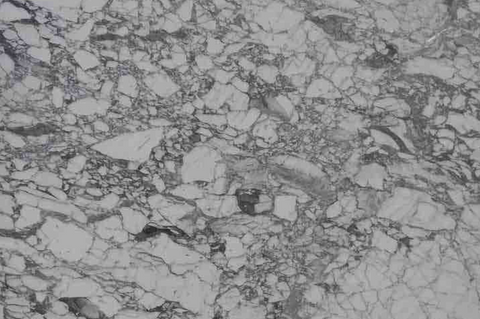Alpes Apuanos. Matthew Savage CC by 2.0
Speaking about marble takes us back inevitably to the Apuan Alps region in Italy. The world’s most important marble deposits are located in this mountain range and some of the most employed varieties in art, design and architecture have been extracted from this spot since the Renaissance. This issue is dedicated to exploring the region from which Arabescato Corchia marble is extracted.

The quarries in the Apuan Alps are subdivided into seven regions from which different kinds of marble are taken: Carrara, Venato, Bardiglio, Nuvolato, Statuario, Calcata, and Arabescato. The latter has an endemic variety from Mount Corchia in the Versilia Province, where mineral sediments in rocks are characterized by gray veining formations. The name arabescato comes from the geometric patterns similar to those in Islamic art, which produce mineral ramifications where dark gray hue contrasts against the white background.

The Versilia region, like other areas in Tuscany, was a development spot for the Medici family. Although marble extraction in this place dates from previous centuries, the precedent of Michelangelo Buonarroti’s Marble Route caused for the commercialization of the rock that characterizes the area still to this day, to flourish. After several decades of conflict between France, Lucca, and Florence, Pope Leo X (Giovanni di Medici) assigned the Versilia region to the Medici family. This was an advantage for the banker family, since they no longer depended on Carrara to obtain marble. With this in mind, the Pope commissioned Michelangelo to find the perfect marble for the façade of the San Lorenzo Basilica (patron Saint of the Medici) in 1513, and to create the infrastructure required to take the material to Florence. Buonarroti traced the foundations to build a road that would allow marble blocks to be transported from Monte Altissimo to Mar Ligure (Ligurian Sea).

The façade of the Basilica was never finished and the contract between Michelangelo and Leon X was canceled in 1520. It was Cosimo I who finished the project, providing the towns of Pietrasanta and Seravezza with a great economic development and Versilia with the infrastructure to position itself as reference for the quality of its marble. The region currently produces 150 tons per year.
Monte Corchia, in addition to producing one of the marble varieties which is remarkable for its decorative features, is characterized by its cave and grotto system. It is the largest system in Italy with over 60 kilometers of inner galleries and represents one of the most treasured resources to understand the weather conditions that led to these mineral formations.

Arabescato Corchia marble is easy to distinguish not only because of its geometric patterns. Its veining always contrasts against the background, unlike other kinds of marble such as Arabescato Brouille or Carrara Venato, its color always features a very light colored base with defined veining in a dark gray hue, which may contain hints of purple, yellow, and brown. Its slabs can be cut in both directions, depending on the kind of composition required. It is a very resistant variety, so it can be placed over almost any surface, turning it into a very striking and classic focal point.



